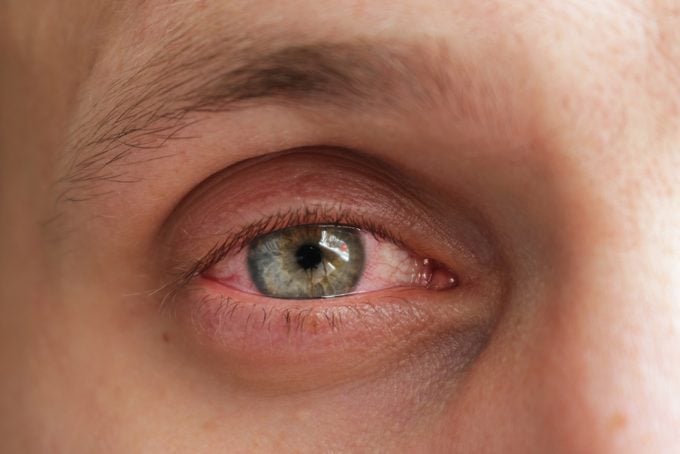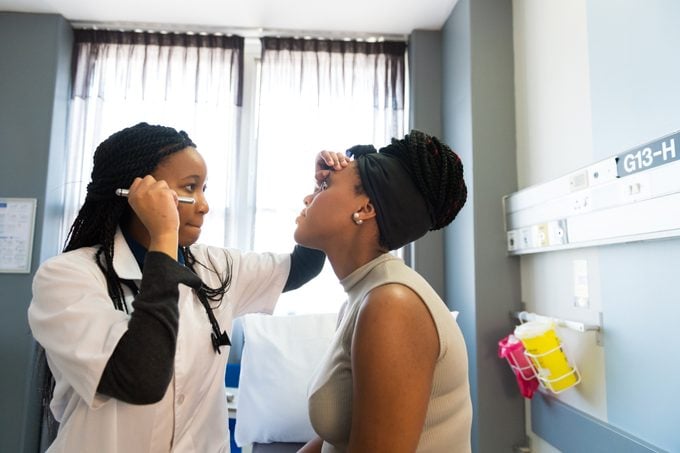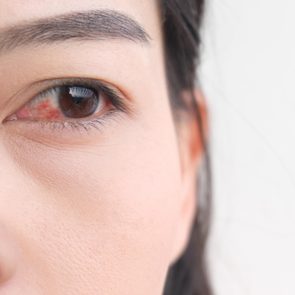How Do You Get Pink Eye? 4 Pink Eye Causes and Treatments
Updated: Oct. 04, 2021
There are four types of pink eye, each caused by a different trigger, and understanding the differences could help with treatment and prevention.
What causes pink eye?
Although people tend to associate conjunctivitis (aka pink eye) with highly infectious viruses, you can actually get it from a number of sources.
“Conjunctivitis just means inflammation of the conjunctiva, which is the lining on the outside of the eye,” explains Leonard Pollack, MD, head of inpatient pediatrics at Henry Ford Medical Group in Detroit.
“It can be caused by viruses. It can be caused by bacteria. It can be caused by allergens.”
In addition to swollen, red eyes, pink eye symptoms include a watery or thick discharge, itching, or pain.
Here is what you need to know about what causes pink eye and the treatment options.

Viral pink eye
Viruses are the most common cause of pink eye, and viral conjunctivitis spreads easily. Adenoviruses, which are responsible for most cases of the common cold, are frequently to blame for conjunctivitis as well.
“When you think of classic pink eye, it’s viral conjunctivitis, and that happens mostly in kids,” says Sonal Tuli, MD, clinical spokesperson for the American Academy of Ophthalmology.
That’s because kids spend so much time in crowded settings like schools and because they don’t wash their hands as often as adults.
Recently, scientists have put pink eye on the list of symptoms that can signal Covid-19 infection, but only in a minority of cases.
Bacterial pink eye
Many of the same bacteria that can cause Strep throat, ear infections, sinus infections, and even some sexually transmitted diseases can also give you pink eye.
Like viral pink eye, bacterial pink eye is contagious, but symptoms may vary a little.
“Bacterial pink eye causes more of a puffy discharge,” says Dr. Tuli, who is also professor and chair of the department of ophthalmology at the University of Florida College of Medicine. “The eyelids are stuck in the morning, and it’s hard to get them open. There’s dried-up pus.”
Allergic pink eye
If you have allergies to pollen, mold, pet dander, dust mites, and especially if you have hay fever, asthma, or eczema, you’re at risk for allergic pink eye.
Unlike the bacterial and viral pink eye, this type of conjunctivitis does not spread from person to person and may look a little different.
“Allergic conjunctivitis tends to be less red and doesn’t have much discharge. If there is a discharge, it’s more tearing than puffy,” notes Dr. Pollack.
Your eyes are also more likely to itch.
Irritant pink eye
Contact with pollutants like cigarette smoke, dust, car fumes, and cosmetics, as well as accidental exposure to certain chemicals, can also cause the redness and swelling of conjunctivitis.
Like allergic pink eye, this form of the condition is not transmissible. Even a loose eyelash straying into your eye can irritate it enough to cause symptoms.
In some cases, wearing contact lenses longer than recommended or dirty lenses can lead to pink eye.
(You may be interested in 18 contact lens mistakes that could ruin your eyes.)
Treatment options
You don’t always need to know what causes pink eye to treat it. All types can benefit from comfort measures like cold compresses to reduce inflammation and pain.
In fact, viral conjunctivitis has no treatment other than artificial tears and home remedies. The infection typically goes away in one to two weeks. In severe cases, a doctor may prescribe antiviral medications.
Some cases of bacterial conjunctivitis may also go away on their own after two weeks (but expect to see some improvement in just a few days).
Other cases require antibiotics in the form of eye drops or ointment. Doctors also often give antibiotics to children with viral pink eye because bacterial infections can occur simultaneously, Dr. Pollack says.
For pink eye from allergies, the trick is to try to avoid the allergen and think about an antihistamine. If a chemical or irritant gets in your eye, rinse your eyes and see a doctor if the symptoms don’t dissipate.
When to get medical help

“If the symptoms persist for more than a couple of days then it’s probably worth being evaluated,” Dr. Pollack says.
Similarly, if you develop a fever, a lot of discharge, pain, or visual changes like blurriness, seek out a doctor’s help.
Newborns are especially vulnerable to more severe viral infections, so it’s important to get a doctor’s opinion if you suspect pink eye in a newborn.
(Learn about 9 subtle signs of a dangerous eye infection.)
How to prevent conjunctivitis
The only way to prevent allergic pink eye is to avoid whatever is triggering the allergy. For bacterial and viral conjunctivitis, it comes down to washing your hands frequently, not touching your eyes, staying away from other people, and not sharing towels, sheets or makeup.
In fact, throw away any makeup, contact lenses, contact lens solution, and lens cases you used while infected. And wash the patient’s laundry separately from the rest of the family’s.















